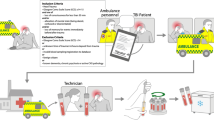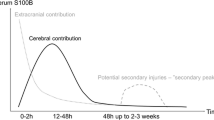Abstract
Purpose
Increased serum biomakers, such as S100 calcium-binding protein B (S100B) and neuron-specific enolase (NSE), are associated with traumatic brain injury (TBI). The purpose of this study is to investigate the serum levels of S100B and NSE in pediatric TBI patients and to predict a clinical outcome.
Methods
Peripheral venous blood was collected within 6 h of injury and at 1 week to measure S100B and NSE. The serum S100B and NSE levels were measured using commercially available enzyme-linked immunosorbent assay kits. The authors divided participants into two groups at admission: a favorable group (patients with Glasgow Coma Scale [GCS] scores of 10–15) and an unfavorable group (patients with GCS scores of less than 9). Both S100B and NSE levels were compared between the two groups at the time of admission and 1 week later.
Results
Ten pediatric patients were enrolled (5 in the favorable group, 5 in the unfavorable group). The median serum S100B level of 134.21 pg/ml (range, 51.00–789.65 pg/ml) in patients with TBI at admission dropped to 41.49 pg/ml (range, 25.65–260.93 pg/ml) after 1 week, with significant differences between the traumatic event and 1 week later (p = 0.007). The median serum NSE level of 14.76 ng/ml (range, 6.48–21.23 ng/ml) in patients with TBI at admission was higher than that after 1 week (4.96 ng/ml, range, 3.01–31.21 ng/ml), with significant differences (p = 0.015). A significant difference was observed in S100B after 1 week between patients in the favorable and unfavorable groups (p = 0.047). One patient whose serum S100B and NSE levels were elevated 1 week after TBI eventually died.
Conclusions
Elevated serum S100B and NSE levels in pediatric TBI patients decreased 1 week after traumatic events. The serum S100B level 1 week after TBI was related to the severity of brain damage. These results indicated that serum S100B and NSE might play a role in predicting the prognosis and monitoring ongoing brain injury in pediatric TBI patients.




Similar content being viewed by others
References
Berger RP, Adelson PD, Pierce MC, Dulani T, Cassidy LD, Kochanek PM (2005) Serum neuron-specific enolase, S100B, and myelin basic protein concentrations after inflicted and noninflicted traumatic brain injury in children. J Neurosurg 103:61–68
Ingebrigtsen T, Romner B (2002) Biochemical serum markers of traumatic brain injury. J Trauma 52:798–808
Vos PE, Lamers KJ, Hendriks JC, van Haaren M, Beems T, Zimmerman C, van Geel W, de Reus H, Biert J, Verbeek MM (2004) Glial and neuronal proteins in serum predict outcome after severe traumatic brain injury. Neurology 62:1303–1310
Beers SR, Berger RP, Adelson PD (2007) Neurocognitive outcome and serum biomarkers in inflicted versus non-inflicted traumatic brain injury in young children. J Neurotrauma 24:97–105
Ingebrigtsen T, Romner B, Kongstad P, Langbakk B (1995) Increased serum concentrations of protein S-100 after minor head injury: a biochemical serum marker with prognostic value? J Neurol Neurosurg Psychiatry 59:103–104
Marchi N, Rasmussen P, Kapural M, Fazio V, Kight K, Mayberg MR, Kanner A, Ayumar B, Albensi B, Cavaglia M, Janigro D (2003) Peripheral markers of brain damage and blood-brain barrier dysfunction. Restor Neurol Neurosci 21:109–121
Rothermundt M, Peters M, Prehn JH, Arolt V (2003) S100B in brain damage and neurodegeneration. Microsc Res Tech 60:614–632
Thelin EP, Jeppsson E, Frostell A, Svensson M, Mondello S, Bellander BM, Nelson DW (2016) Utility of neuron-specific enolase in traumatic brain injury; relations to S100B levels, outcome, and extracranial injury severity. Crit Care 20:285
Ramont L, Thoannes H, Volondat A, Chastang F, Millet MC, Maquart FX (2005) Effects of hemolysis and storage condition on neuron-specific enolase (NSE) in cerebrospinal fluid and serum: implications in clinical practice. Clin Chem Lab Med 43:1215–1217
Kellermann I, Kleindienst A, Hore N, Buchfelder M, Brandner S (2016) Early CSF and serum S100B concentrations for outcome prediction in traumatic brain injury and subarachnoid hemorrhage. Clin Neurol Neurosurg 145:79–83
Herrmann M, Jost S, Kutz S, Ebert AD, Kratz T, Wunderlich MT, Synowitz H (2000) Temporal profile of release of neurobiochemical markers of brain damage after traumatic brain injury is associated with intracranial pathology as demonstrated in cranial computerized tomography. J Neurotrauma 17:113–122
de Kruijk JR, Leffers P, Menheere PP, Meerhoff S, Twijnstra A (2001) S-100B and neuron-specific enolase in serum of mild traumatic brain injury patients. A comparison with health controls. Acta Neurol Scand 103:175–179
Stålnacke BM, Björnstig U, Karlsson K, Sojka P (2005) One-year follow-up of mild traumatic brain injury: post-concussion symptoms, disabilities and life satisfaction in relation to serum levels of S-100B and neurone-specific enolase in acute phase. J Rehabil Med 37:300–305
Savola O, Pyhtinen J, Leino TK, Siitonen S, Niemelä O, Hillbom M (2004) Effects of head and extracranial injuries on serum protein S100B levels in trauma patients. J Trauma 56:1229–1234
Gazzolo D, Michetti F, Bruschettini M, Marchese N, Lituania M, Mangraviti S, Pedrazzi E, Bruschettini P (2003) Pediatric concentrations of S100B protein in blood: age- and sex-related changes. Clin Chem 49:967–970
Thompson WH, Thelin EP, Lilja A, Bellander BM, Fransson P (2016) Functional resting-state fMRI connectivity correlates with serum levels of the S100B protein in the acute phase of traumatic brain injury. Neuroimage Clin 12:1004–1012
Bandyopadhyay S, Hennes H, Gorelick MH, Wells RG, Walsh-Kelly CM (2005) Serum neuron-specific enolase as a predictor of short-term outcome in children with closed traumatic brain injury. Acad Emerg Med 12:732–738
Cotena S, Piazza O, Storti M (2006) The S100B protein and traumatic brain injury. J Neurosurg 104:435–436
Jackson RG, Samra GS, Radcliffe J, Clark GH, Price CP (2000) The early fall in levels of S-100 beta in traumatic brain injury. Clin Chem Lab Med 38:1165–1167
Ingebrigtsen T, Romner B (2003) Biochemical serum markers for brain damage: a short review with emphasis on clinical utility in mild head injury. Restor Neurol Neurosci 21:171–176
Korfias S, Stranjalis G, Boviatsis E, Psachoulia C, Jullien G, Gregson B, Mendelow AD, Sakas DE (2007) Serum S-100B protein monitoring in patients with severe traumatic brain injury. Intensive Care Med 33:255–260
Undén L, Calcagnile O, Undén J, Reinstrup P, Bazarian J (2015) Validation of the Scandinavian guidelines for initial management of minimal, mild and moderate traumatic brain injury in adults. BMC Med 13:292
Berger RP, Bazaco MC, Wagner AK, Kochanek PM, Fabio A (2010) Trajectory analysis of serum biomarker concentrations facilitates outcome prediction after pediatric traumatic and hypoxemic brain injury. Dev Neurosci 32:396–405
Graham EM, Everett AD, Delpech JC, Northington FJ (2018) Blood biomarkers for evaluation of perinatal encephalopathy: state of the art. Curr Opin Pediatr 30:199–203
Serpero LD, Pluchinotta F, Gazzolo D (2015) The clinical and diagnostic utility of S100B in preterm newborns. Clin Chim Acta 444:193–198
Funding
This work was supported by Biomedical Research Institute grant (No.2016-General-08), Kyungpook National University Hospital (2016).
Author information
Authors and Affiliations
Corresponding author
Ethics declarations
Conflict of interest
On behalf of all authors, the corresponding author states that there is no conflict of interest.
Rights and permissions
About this article
Cite this article
Park, DW., Park, SH. & Hwang, SK. Serial measurement of S100B and NSE in pediatric traumatic brain injury. Childs Nerv Syst 35, 343–348 (2019). https://doi.org/10.1007/s00381-018-3955-y
Received:
Accepted:
Published:
Issue Date:
DOI: https://doi.org/10.1007/s00381-018-3955-y




